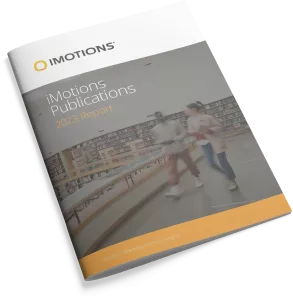-
A framework for studying design thinking through measuring designers’ minds, bodies and brains
Abstract: This paper presents a framework for studying design thinking. Three paradigmatic approaches are described to measure design cognitive processes: design cognition, design physiology and design neurocognition. Specific tools and methods serve each paradigmatic approach. Design cognition is explored through protocol analysis, black-box experiments or surveys and interviews. Design physiology is measured with eye-tracking, electrodermal […]
-
Facing Driver Frustration: Towards Real-Time In-Vehicle Frustration Estimation Based on Video Streams of the Face
Drivers frequently experience frustration when facing traffic jams, red lights or badly designed in-vehicle interfaces. Frustration can lead to aggressive behaviors and negative influences on user experience. Affect-aware vehicles that recognize the driver’s degree of frustration and, based on this, offer assistance to reduce the frustration or mitigate its negative effects promise remedy. As a […]
-
Modeling the Relationships Between Basic and Achievement Emotions in Computer-Based Learning Environments
Commercial facial affect detection software is typically trained on large databases and achieves high accuracy in detecting basic emotions, but their use in educational settings is unclear. The goal of this research is to determine how basic emotions relate to the achievement emotion states that are more relevant in academic settings. Such relations, if accurate […]
-
Using Eye-Tracking to Understand Human Responses to Traditional Neighborhood Designs
New research in brain and cognitive science is changing how we understand how people perceive and experience the built environment, offering key opportunities for urban planning, urban design, and architecture. Sixty-three college students looked at different scenes of New York City public buildings in a set up with an eye tracker in front of a […]
-
A post-paradigmatic approach to analysing emotions in social life
Scholars studying emotions in social life typically work mono-logically, within a paradigmatic camp, drawing on distinct theories of emotion. In isolation, each offers a singular conceptualisation of emotions in social life. Working multi-logically, in contrast, offers richer, comparative insight into the layered meanings of emotion relevant to a social context. Rather than treating them as […]
-
Influences of sensory attribute intensity, emotional responses, and non-sensory factors on purchase intent toward mixed-vegetable juice products under informed tasting condition
Abstract: Product-related sensory and non-sensory cues have been studied in the past to understand purchase behavior among consumers. However, there has been little research related to integrating emotional responses with such cues to achieve better prediction of consumer purchase behavior. This study aimed to determine the impacts of sensory attribute intensities (SAI), non-sensory factors (NSF), […]
-
Neurophysiological Effects of Presence in Calm Virtual Environments
Presence, the feeling of being there, is an important factor that affects the overall experience of virtual reality. Presence is measured through post-experience subjective questionnaires. While questionnaires are a widely used method in human-based research, they suffer from participant biases, dishonest answers, and fatigue. In this paper, we measured the effects of different levels of […]
-
Does visual framing drive eye gaze behavior? The effects of visual framing of athletes in an increasingly visual social media world
Previous research on the effects of visual framing of athletes has inferred that photographic visual frames drive visual behavior by demonstrating that visual frames influence picture viewers’ evaluative ratings and memory for the pictures. This study uses eye-tracking methodology to ask if these previous findings are actually the result of visual frames driving eye gaze/visual […]
-
Storytelling, the scale of persuasion and retention: A neuromarketing approach
Persuasive storytelling is an essential tool for propagandists, publicists, and corporations. In this research, storytelling styles have been examined for their effectiveness in terms of attitude change and retention. Two groups of respondents were asked to read two short, fictional texts about a chosen corporation’s positive action toward the environment. One story was written using […]
-
Investigating Representation of Text and Audio in Educational VR using Learning Outcomes and EEG
This paper reports findings from a between-subjects experiment that investigates how different learning content representations in virtual environments (VE) affect the process and outcomes of learning. Seventy-eight participants were subjected to an immersive virtual reality (VR) application, where they received identical instructional information, rendered in three different formats: as text in an overlay interface, as […]
Research Report 2023
In-depth look at the scientific landscape as powered by iMotions software, showcasing groundbreaking research and the impact of our tools in various scientific and industrial fields.

Share Your Research

850+ universities worldwide with an iMotions human behavior lab
73 of the top 100 highest ranked universities
710+ published research papers using iMotions
iMotions is used for some of the most interesting human behavior research studies carried out by top researchers around the world. Contact us to have your publication featured here.
The authors of these publications have used iMotions as a software tool within their research.
“Software should be cited on the same basis as any other research product such as a paper or a book; that is, authors should cite the appropriate set of software products just as they cite the appropriate set of papers” (Katz et al., 2020).
We therefore encourage you to cite the use of iMotions where appropriate.
How to cite iMotions
APA
iMotions (10), iMotions A/S, Copenhagen, Denmark, (2024).
Note: adjust the version and year where relevant.
5 Most Popular Blogs
Learn How to Conduct Human Behavior Research with iMotions
Publications
Read publications made possible with iMotions
Blog
Get inspired and learn more from our expert content writers
Newsletter
A monthly close up of latest product and research news





